Five tips for camping with kids
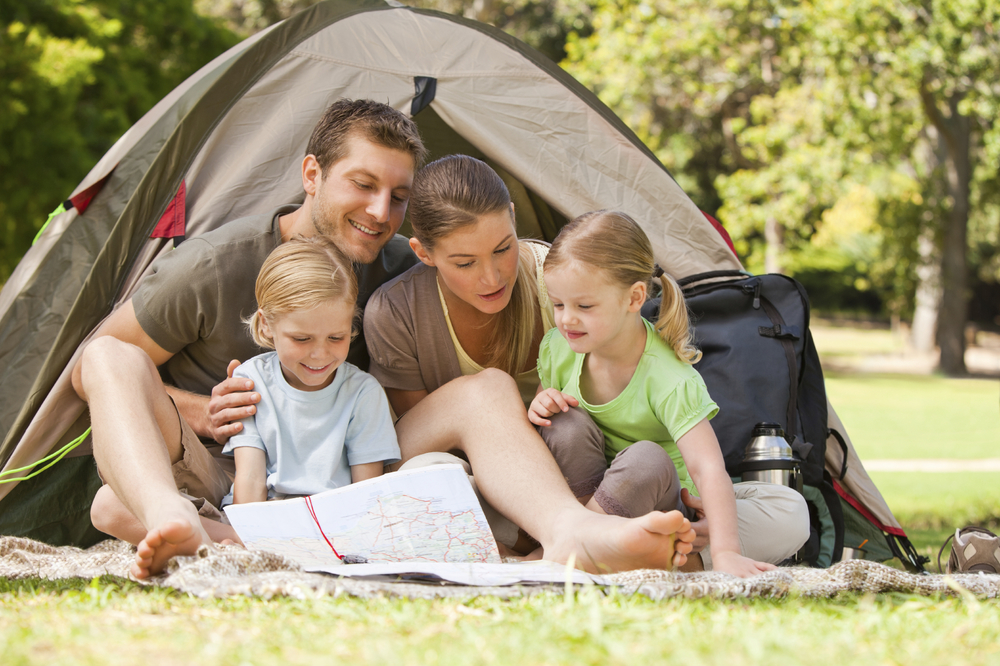
Before kids, my husband and I camped. A lot. We knew just what to pack and had our camp set up down to a science. Our trips were relaxing, stress free, and often landed us in some remote spots, far removed from the city life and its amenities. Once kids entered our lives, we both decided that camping was something we wanted to continue to do and experience as a family. The first couple of times out, we quickly realized that we were no longer the experts we thought we were! Our game plan needed to change dramatically if this was going to work. After a couple of semi-disastrous experiences, we learned a few things, most importantly the value in being prepared (over prepared really). If you are interested in family camping and are ready to take the plunge, here are my top 5 tips for a successful trip along with a few of my favourite camping memories.
1. Location, Location, Location
Long gone are the days of camping off the grid (at least for now!). When venturing out with kids, amenities are your friend. Whether you are tenting or in a trailer, you may want to consider a site that has:
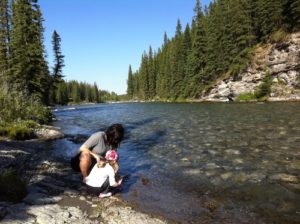 running water (a shower is a bonus!)
running water (a shower is a bonus!)- bathrooms with flush toilets (do yourself a favour and find a site close to one)
- a prepared fire pit with an unlimited wood supply (most sites will charge you for this) and a grate for cooking
- a flat pad for a tent, if you are tenting, and
- an on-site store or nearby town for any needed (or forgotten) items.
Most government run parks have informative websites to help you chose a suitable location. It helps to phone in advance and inquire about child friendly sites (for example, campgrounds that have a playground or interpretive program). Consider possible hazards when choosing a location such as near-by bodies of water, steep drop offs or proximity to busy roads or deep forests.
2. Pack Wisely
This is the most labour intensive part of the trip but also the most important. The key here is to over prepare. You never know what kind of weather you will get or what kind of adventures you may find yourself in. There are many kid friendly checklists to choose from, such as this one from Campers Village. Choose one that best suits your needs and personalize it as you see fit. Print it off and bring it with you. This way you can add or delete items as needed to better prepare for your next outing. If you have a little one, a pack-and-play is a must for sleeping as well as providing a safe spot to contain them. Bring a potty, if applicable, to avoid accidents and to save yourself from running back and forth to the bathroom. (Check out the BabyBjörn Travel Crib and Smart Potty). Phil &Teds portable high chair is small, easy to pack and can clip onto a picnic table (this product is worth its weight in gold!).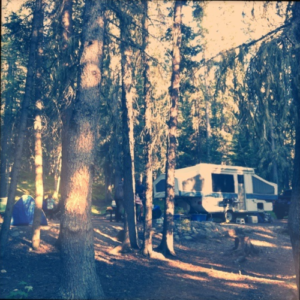
3. Keep Meals Simple
Plan your menu before you go and keep in mind that one-pot meals and food you can cook over the campfire are a great idea. Prep your food before you go. Wash all fruit and vegetables. Chop all veggies and put them into zip lock bags. Pre-mix your pancake batter and store in a sealed glass container. Precook your rice. Marinade your meat ahead of time so it’s ready to go. Have loads of high-energy snacks that do not require prep (including cheese sticks, granola bars, trail mix, bananas, dehydrated fruit, juice boxes and water bottles). S’mores are a camping tradition and a must for evening campfires!
4. Activities For Kids
There are unlimited, unstructured activities to do with your kids. While they will likely find their own fun, some ideas to help keep them engaged include:
- Helping to set up camp – allow them to help set up the tent, collect the firewood and kindling, fill the water container and set up the hammock. Kids love to help out and it will give them some ownership of the campsite!

- Going on a nature walk/scavenger hunt – nothing beats a stroll through nature. If preparation is your thing, create or print off a scavenger hunt checklist, complete with items they would likely find, or simply have them spot or collect items in nature that grab their interest. Have paper bags or empty egg cartons for collecting items. Bring along a bug catcher and magnifying glass for observing interesting creatures. While walking, encourage them to use all their senses (What can you hear? What does the bark feel like? What does the moss smell like? How many different flowers can we find?) . This may be a good time to discuss nature etiquette, such as not picking wildflowers. Be aware of any poisonous plants native to the area and what they look like.
- Stargazing – kids of any age will enjoy laying on their backs staring into the night sky. Read a book before hand like, The Big Dipper by Franklyn M. Branley and see if you can spot it. For a more detailed look, you may want to try SkyView (a free app that allows you to point your mobile device to the sky to identify constellations) or print off a star chart to help identify specific constellations.
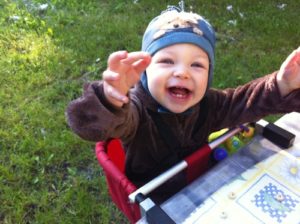
- Photo taking – hand over the camera around camp or while out on an adventure. This helps to keep your kids engaged and usually provide you with some pretty interesting and sometimes comical pics!
- Rainy day activities – rainy camping days can break the best of us. Have a repertoire of activities ready such as board games (Mexican train is a favourite) and playing cards. Colouring and sticker books are also great to have on-hand for times you are stuck inside. My other advice for rainy days is to embrace them. Put on the rain gear and head out for some fun.
5. Safety Considerations
No matter how safety conscious you are, the unexpected can always happen. The key is to be preventative and well equipped to deal with whatever may occur. Some suggestions include:
- Prepare a first-aid kit and have it accessible. Get Dr. Pam’s natural first aid kit list here.
- Discuss fire pit safety – everyone loves a campfire but rules should be established to prevent any serious injury. Some things to consider are: no running around or playing by the fire, no putting items into fire without adult supervision, sit a safe distance from fire (discuss how fires can spark), avoid loose clothing and bare feet, and have a long stick and adult support when roasting food. After cooking, adults need to have a safe spot for all hot pots and utensils once off the fire.

- Have a plan if separated – provide your child with a neon light and whistle on a lanyard. They are practical and kids love to wear them. Have a plan in place for what to do if they get lost (for example: hug a tree, stay put and blow your whistle).
- Prepare for the dark – get things organized before you need them (brush teeth, put on pj’s, tidy up camp, have wood chopped). As mentioned before, provide kids with neon lights. Headlamps are useful if you need to maneuver through the dark and they allow you to have your hands free.
- Establish exploration boundaries – use landmarks to identify areas they cannot pass (for example – don’t wander past the wood pile or farther than the hammock). If you can find it, use barricade (police) tape to tape off a safe zone (this may seem ridiculous but it really does work!).
- Be animal smart – never feed or approach an animal (even the cute ones!) and be aware of any recent animal sightings in the area. Most campgrounds have a bulletin board by the check in station where you can find out this information.
- Protect against ticks and mosquitoes – there are preventative measures and sprays you can buy as well as alternative, non chemical solutions you can make at home.

While it may seem like a lot of effort (and it is), don’t let the work deter you. Camping truly is a wonderful opportunity to unplug, reconnect with nature and create some long lasting memories with your family! Be well planned, keep an open mind (don’t fret if bedtime does not go as planned the first night!) and most importantly– embrace it, get dirty, find your inner child and have fun!
About the author
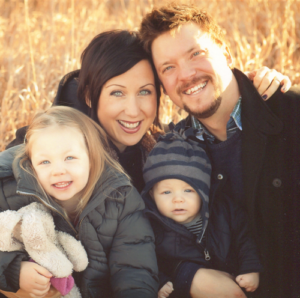 Terri Dragatis is a wife, Mother of two, and a teacher. Her diverse interests and ability to turn everything into a lighthearted lesson, not to mention her witty quips and great sense of humor, make her an invaluable part of our team.
Terri Dragatis is a wife, Mother of two, and a teacher. Her diverse interests and ability to turn everything into a lighthearted lesson, not to mention her witty quips and great sense of humor, make her an invaluable part of our team.
As a new parent, Terri remembers feeling overwhelmed and frustrated with the abundance of information and wished she had effective, simple and condensed reference guides that would support us, particularly with sleep training. She believes Calm Parent Sleep Routine and other resources will provide many parents with quick to access, useful information to support you throughout your parenting journey.
For Terri, balance involves spending quality time with her family in and outdoors, cooking, camping and goofing around, getting out with friends or for a date with her husband now and again, and fitting in as much as exercise as she can.
Sleep is so important but the optimal amount is different for each family member.
It depends on age and other factors.
Find out the healthy sleep ranges by age, for you and your growing family.
Starting with babies (newborn to one year),
toddlers, preschoolers, school aged
children, teens and adults.
Guide to optimal family sleep (daytime naps & at night)
FREE download
Be the first to know about special
offers and resources
for our community only.
Don't miss out!
Become a Calm Parent Insider
FREE gifts & resources
CALMMOTHER LIMITED © 2023 | ALL RIGHTS RESERVED
terms | privacy | contact
Simplifying life for parents so you can focus on what matters most to you.
Live your best life with kids!
+ Show / Hide Comments
Share to: